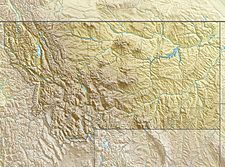Harrison Glacier facts for kids
Quick facts for kids Harrison Glacier |
|
|---|---|
| Type | Mountain glacier |
| Location | Glacier National Park, Flathead County, Montana, United States |
| Coordinates | 48°35′34″N 113°43′49″W / 48.59278°N 113.73028°W |
| Area | 466 acres (189 ha) in 2005 |
| Length | .50 mi (0.80 km) |
| Terminus | Barren rock/talus |
| Status | Retreating |
A glacier is like a very slow-moving river of ice. It forms over many years as layers of snow pile up and get pressed into thick ice.
Harrison Glacier is one of these amazing ice rivers. You can find it in the United States, in Glacier National Park, which is in the state of Montana. It sits on a ridge that faces southeast, just south of Mount Jackson.
Harrison Glacier: A Special Ice Giant
Harrison Glacier is quite special because it is the biggest glacier left in Glacier National Park. In 2005, scientists estimated it was about 466 acres in size. To give you an idea, that's like more than 350 football fields!
Why Harrison Glacier is Different
Many experts have worried that all the glaciers in Glacier National Park might melt away by the year 2030. But Harrison Glacier is holding on much better than others. Between 1966 and 2005, it only lost about 9 percent of its surface area. This means it will probably still be around long after 2030.
So, why is it doing better? A big reason is where its "accumulation zone" is located. This is the part of the glacier where new snow falls and builds up. For Harrison Glacier, this zone is very high up, about 9,000 feet (or 2,743 meters) above sea level. Because it's so high, the temperatures are colder, and more snow can collect. This helps the glacier stay balanced, meaning it doesn't lose too much ice.
How Glaciers Change Over Time
Scientists can learn a lot about glaciers by comparing old photos with new ones. Pictures of Harrison Glacier taken in 1913 and then again in 2009 show that the glacier has become thinner. It has also "retreated," which means its edges have moved back. Even though it's shrinking, Harrison Glacier is still a great example of how some glaciers can resist melting more than others.


